| ~~~~~~~~~~~~~~~~~~~~~~~~~~~~~~~~~~~~~~~~~~~~~~~~
National Association of Rocketry
Educator's Newsletter
August 2019
~~~~~~~~~~~~~~~~~~~~~~~~~~~~~~~~~~~~~~~~~~~~~~~~ |

Soon?
As we passed through the Apollo 11 anniversary of the first lunar landing the question brought up during the various observances was, "Are we going back?" and "When?" One astronaut said ever since the 1970's the answer from NASA was "of course we are, five years from now." Whenever you asked, it was always five years out. And it's what they are saying today..."2024." As much of a political dodge as the phase has been, we are, in the scope of human history, closer to going back to the moon than we were a few decades ago.
Yet, it might not be the crews in the present astronaut corps who go. Those destined to make the next footprints in the lunar dust may be in your classroom this coming school year. Will you teach them to build a model rocket so they can someday ride a moon rocket? NAR can train you.
Visit the NAR rocket teacher certification page at
http://www.nar.org/educational-resources/welcome-to-nartcert/
and investigate the online program to get your kids excited about ST
EM! O
therwise, the next moon shot will always be five years away.
Aim high!
Vince Huegele
NAR Education Chairman
|
|

The American Rocketry Challenge 2019 and 2020
On June 20th and 21st, students from Madison West High School, Madison, Wisconsin competed against the best student rocketeers in the world at the International Rocketry Challenge (IRC).
From 830 teams across the country, to the top 101 teams competing in Virginia, to the top 4 teams in the world, the U.S. team earned 2nd place in what was the CLOSEST International Rocketry Challenge in history as they went head-to-head
against teams from the United Kingdom, France, and Japan at the Paris International Air Show. Well done team M
adison West:
Mazelie Passmore (14), Ella Paulin (15), Ethan Lan (15), Rohan Yethiraj (15), Jacob Mello (15), Lukas Weinhold (14), Alex Goff (15), and Nathan Wagner (15)
!
As you can tell from the new headline, "TARC" now stands for "The American Rocketry Challenge". Our AIA partners thought
it was time for rebranding this event. Their statement about the rebranding says: "Our objective was to create a brand that is more accessible and attractive to students who are, or could be, interested in rocketry and aerospace. Further, a rebrand would allow us to better reflect the goals, accomplishments, and stories that have become an integral part of the competition. Since then, our larger Communications and Strategy Teams initiated a process that included research and discussions, to distill the core strengths of our current branding and our mission statement ("To create and inspire the next generation of the America aerospace workforce"-) to develop our new identity."
Our AIA partners are 100 percent behind making TARC bigger and more successful and they have added a staff of full-time professional media and communications people who are working hard to expand TARC. As a result of their work this was the biggest TARC since the first year. Since we can still call it "TARC" and it still has "Rocketry" in the title, I told them to go for it on the rebranding. They don't tell us how to fly rockets, we don't tell them how to market (or raise the corporate sponsorship money that pays for TARC). Our partnership brings the strengths of each organization to bear in order to achieve team success!
The 2020 The American Rocketry Challenge
is open to the first 1000 teams that submit a completed application, including payment, postmarked between September 1 and December 1, 2019.
Key elements of the challenge are:
- 800 feet, 40 - 43 seconds for qualification flights
- 1 egg, any orientation
- All parts must recover connected, using a parachute
- No specifications for body diameter or parachute size
- Still have to be painted at the Finals, but no Saturn 5 resemblance event
- FIRST flight at the Finals will be 25 feet higher or lower than 800 feet based on coin flip Friday night, SECOND flight will be the other - no flights at the Finals will have 800 feet as the goal. Durations adjusted by 1 sec tracking the altitude.
Selection for the Finals will be based on the sum of the best two of up to three qualification flight reports a team submits by April 6.
TARC gives students opportunities to apply their math and science skills to a real world project outside of the classroom. For many students, this experience yields their first significant personal realization of how what they are learning in school is relevant to the fun and challenging endeavors representative of potentially future career pathways. Through TARC, students have discovered they enjoy solving math and science problems in the context of resolving difficult and complex design issues. Often TARC is also their first exposure to the aerospace industry. They learn what aerospace engineers and skilled technical workers do and what it takes to become one of those professionals.
Take the challenge!
|
 NAR Scholarship Program, Robert L. Cannon Award, and Extracurricular Activity Grant Awards NAR Scholarship Program, Robert L. Cannon Award, and Extracurricular Activity Grant Awards
Did you know that if you are NAR member between the ages of 17 and 22 attending college or a vocational school that you may be eligible to receive a scholarship?
Are you a teacher or educator who uses model rocketry in the classroom? You are welcome to apply for a $500 grant to use in your program.
In 2001, the NAR's scholarship and Robert L. Cannon educational awards were inaugurated.
Three NAR members received scholarships and two educators received Cannon awards. Over the years the number of award winners have grown. In 2015, a new program, the NAR Extracurricular Activity Grant (EAG) was initiated to provide up to ten $500 grants for after-school activities, such as rocket clubs, scout, Civil Air Patrol, 4-H, or NAR section programs involving model rocketry. TARC teams are not eligible for these awards. This year we awarded ten $2000 scholarships, six $1000 scholarships, six Cannon $500 grants, and one Extracurricular Activity Grant (EAG).
The deadline is June 1st of each year.
|
INSPIRING OTHERS
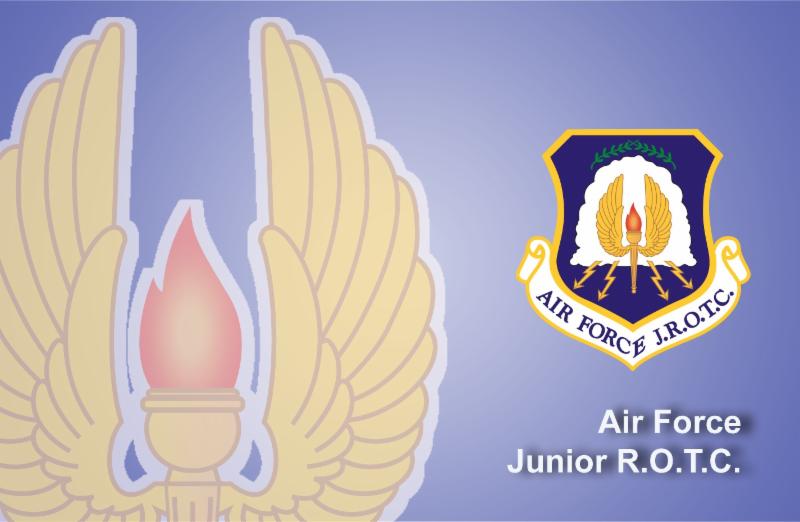 Air Force JROTC
Air Force JROTC
As of May 2017, NAR signed a MOU with the Air Force Junior Reserve Officer Training Corps (AFJROTC) to foster greater cooperation among NAR Sections and AFJROTC Squadrons to encourage joint rocketry activities.
The Air Force JROTC provides leadership training and an aerospace science program for high school students. Secondary school students who enroll in the AFJROTC program are offered a wide variety of curricular and extra-curricular activities. The program explores the historic and scientific aspects of aerospace technology and teaches high school students self-reliance, self-discipline and other characteristics found in good leaders. The AFJROTC program is open to 9th-12th grade students who are citizens of the United States. There are more than 121,000 high school cadets in the program and over 1,950 retired USAF instructors who lead, mentor, guide, and teach the cadets in high schools. AFJROTC enjoys overwhelming school administration and community support because of the huge positive impact on cadets, schools, communities, and our nation. The program is not a recruiting tool for the military services and those students who participate in AFJROTC do not incur any obligation to the Air Force, but the students do wear uniforms and follow military type protocol in their classes and activities.
Get to know your AFJROTC Unit Commander or their education officer and see how you might work together to promote model rocketry.
To find your local unit,
look here
and the search engine will generate a map with unit locations and contact information. You can also do a simple web search to find the many AFJROTC rocket activities. Alternately, f
or more information on AFJROTC, contact AFJROTC Headquarters, 60 West Maxwell Blvd., Maxwell AFB, AL 36112-6501; phone 1-334-953-7513,
online.
Civil Air Patrol
Collectively, we can have a remarkable impact on a partnering national organization. Take the time to contact a
local Civil Air Patrol squadron
near you and Pay Forward! Each of these squadrons would welcome your insights and camaraderie! Additionally, the Civil Air Patrol has an Advanced Rocketry Program (and Guide) for those folks who enjoy High Power Rocketry as well as Mid and Low Power...It's a great opportunity to share experiences and Pay Forward!
Edwards Hosted 4th Annual Education Science Technology Engineering Math Academy
The Edwards AFB 412th Test Wing hosted the California Wing Civil Air Patrol Wing Aerospace Education Science Technology Engineering Math Academy from Sunday, June 16 through Sunday, June 23.
Dr. David G. Smith, the 412th TW installation support director, with Col. Alan Ferguson, CAWG commander; Col. Roger Dunn, CAWG director aerospace education; and Lt. Col. Rich Radvanyi, CAWG Group 6 Commander and liaison officer, USAF retired; have combined their knowledge and expertise in arranging base tours including the vast flight line assets of the B-2 Spirit stealth fighter, the F-22 Raptor, and the F35 Lightening II, the Tracon Tower, the Test Pilot School, the Air Force Rocket Lab, the robotics demonstration at Explosives Ordinance Disposal and the Emerging Technologies/Controlled Test Flight.
New Jersey Wing, Joint Base McGuire-Dix-Lakehurst
The NJ Wing of Civil Air Patrol is enjoying a "re-birth" in rocketry and Colonel Steven Tracy is leading the front! Work with base partners at Lakehurst Naval Air Station, the New Jersey Wing has gained permission to launch once again launch rockets near the area where the Hindenburg crashed. No one has launched there since 1996! Check out
the video!
Missouri Wing, Whiteman AFB
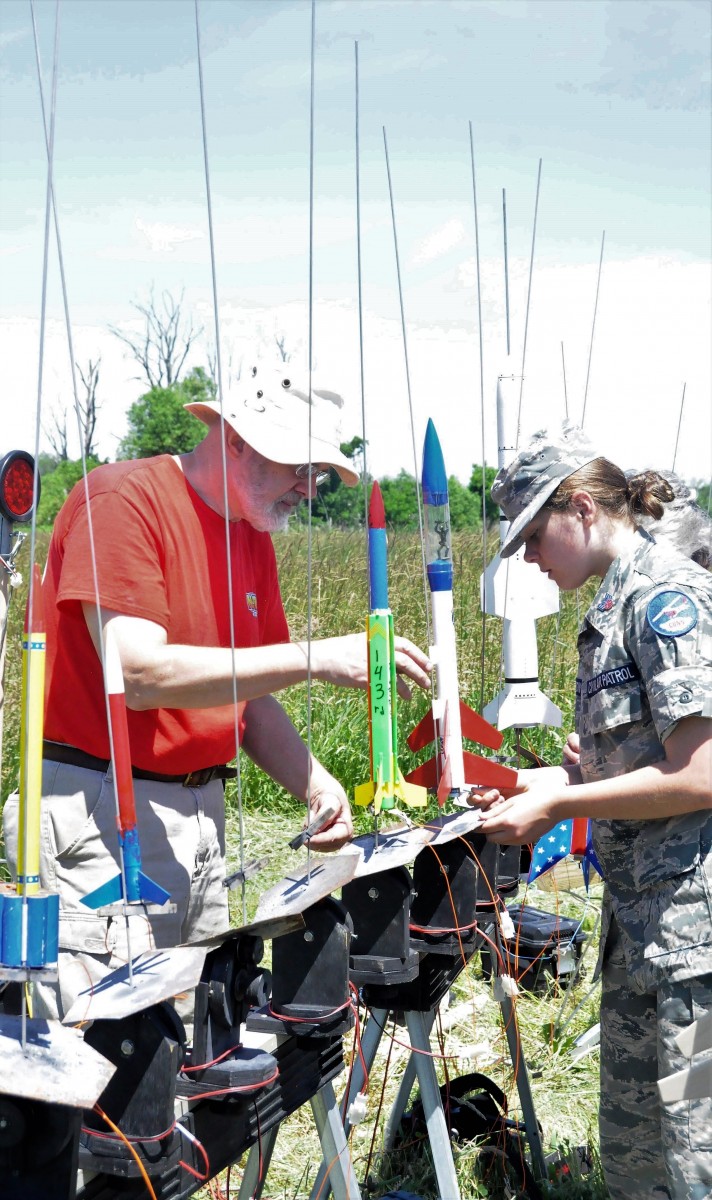 Connecticut Wing, Thames River Composite Squadron Connecticut Wing, Thames River Composite Squadron
The Connecticut Wing holds an annual the Commander's Cup Rocketry Contest.
The contest began in 2007 when Col. Peter Jensen, then the Connecticut Wing's commander, encouraged Lt. Col. Stephen Rocketto, director of aerospace education. To institute the competition. Jensen donated the silver cup to be engraved each year with the name of the winning squadron.
The contest is designed to assist cadets in earning the Civil Air Patrol Rocketry Badge. Each class of entries features one of the rockets that must be built to earn the badge.
The annual event has been sponsored by NAR section #581,
CATO
. The Connecticut Wing thanks CATO's president, Eric Henderson, and vice president, Brad Oestreicher, for their generosity and support!
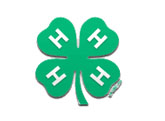 4-H 4-H
4-H Uses Model Rocketry for Science, Technology, Engineering and Math
Estes
Presidential Awards for Excellence in Science, Mathematics and Engineering Mentoring
Established by the White House in 1995, this Presidential award recognizes U.S. citizens, permanent residents and organizations that have demonstrated excellence in mentoring individuals from groups that are underrepresented in science, technology, engineering, and mathematics (STEM) education and workforce. These STEM groups include women, people with disabilities, underrepresented racial and ethnic minorities, individuals from low socio-economic backgrounds and geographic regions like urban and rural areas. The PAESMEM program is administered by the National Science Foundation (NSF) on behalf of the White House Office of Science and Technology Policy.
LOC Precision
Rockets for Schools
On May 3 & 4, 1996, 240 students participated in the first state-based Rockets For Schools program. NASA Administrator Dan Goldin addressed the students along with Astronaut Col. Mark Lee. Students were briefed on the different aspects of the launch and were given a tour of the different launch stations. 12,000 people were in attendance, as Sheboygan, Wisconsin became the first inland sub-orbital launch site.
Since 1996, we have had over 20 successful secondary school launches involving students from Wisconsin, Michigan, Illinois and Iowa but participation is open to all U.S. students in grades from 6 through 12. This event provides an opportunity for students to participate in aerospace technology and rocket launches: to learn about rocket construction and to perform as part of a team.
Rockets For Schools
is a fun and exciting way for kids to learn about space technologies while providing them with an opportunity to be part of an extraordinary team-building event. Additionally, Rockets for Schools is the only other NASA Student Launch Initiative qualifier outside of TARC. For more information write to Rockets For Schools,
P. O. Box 684 Sheboygan, WI 53082-0684, call (920) 458-6299, or email
Carol Lutz and
Kenny Bergschultz.
Fun 2 Discover
Fun 2 Discover provides interactive STEAM based learning tools and resources.
Fun 2 Discover encourages students to learn Science, Technology, Engineering, the Arts and Mathematics (STEAM) through a unique, incentive-based points system.
The more STEAM you learn, the more POINTS you earn!
Fun2Discover encourages our users to get involved with Science, Technology, Engineering, the Arts and Mathematics through a unique, incentive-based points system and contests.
Every STEAM-based activity on Fun2Discover can earn our members points, earn enough points and you could win great STEAM prizes. For more information contact
STEAM Club Strategies, Inc.,
Fun2Discover,
Harbourside Center
110 Front Street, Suite 343, Jupiter, Florida, 33477 or call
800-896-8716.
American Institute of Aeronautics and Astronautics
Check out the
AIAA Educator Academy pages on the AIAA website to learn more about the curriculum and the instructors. Workshops are being set up around the country in local AIAA sections, so check the website to see where the next one will be located. Interested now? Why wait! We have webinars scheduled for educators to learn more about each program.
|
| RESOURCES 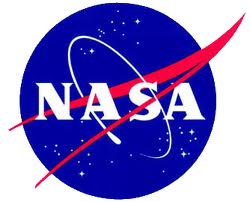 Adventures in Rocket Science Educator Guide Adventures in Rocket Science Educator Guide The "Adventures in Rocket Science Educator Guide" is available for download from the NASA website. Education specialists from the Marshall Space Flight Center created this curriculum with members of the NAR. The material was tested in a workshop pairing NAR members in the MSFC area with informal educators from science centers, 4-H clubs, Girl Scout troops and after-school programs to introduce the groups to how to use the guidebook with students in informal settings. The Guide has activities for grades K-12 and serves as a program to progressively prepare students for participating in TARC. |
|
Estes
Apogee
Apogee Components has an extensive educator's page and a remarkable newsletter archive
http://www.apogeerockets.com/Education. If you want to subscribe to their newsletter just look at the right hand column of the Educator's page and you will see the sign-up section.
eRockets
eRockets has a
dedicated web site full of tips for educators! D
esigned for educators wanting to introduce this safe, educational, and fun hobby to their students, it's especially focused on the classroom educator, scout leader, church leader, 4-H Leader, or space enthusiast who wants to incorporate model rocketry into a group activity.
|
 NAR Offers Teachers and Youth Group Leaders Resources NAR Offers Teachers and Youth Group Leaders Resources
Are you starting your rocketry program and aren't sure what rockets are right for your kids? Contact your local NAR Section to help with your program. Having worked with teachers, Section members can provide valuable advice about planning the time you have scheduled and purchasing rocket products tailored to your needs and launch site. For instance, did you know it takes a typical 8th grade class about two days to build a rocket with balsa fins? As you might expect, the age of your students and the size of your class are also factors in determining the right type of kit and the amount of time to complete it. Indeed, based on the size of your launch site, a streamer recovery rocket (as opposed to a parachute recovery) might be a better option for your students as the chances for a successful return (and a chance for additional flights) would be greater.
In addition, The NAR offers Free Resource downloads produced by members who have helped teachers and youth group leaders like yourself all over the United States.
Would you like to have a rocketry program at your school or know more about how to use rockets to teach math and science? Please take advantage of our field experience in educational rocketry by completing our survey. That signs you up for both our Email Educator Newsletter, and our free Rocketry Resource Portal You and your students will be "go for launch."
|
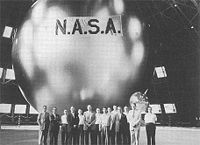 Space History Space History
August 12, 1960: NASA launched its first communications satellite, Echo 1. Echo 1 rode to space on a Thor-Delta rocket from Vandenberg Air Force base, California. The satellite transmitted a signal from President Dwight D. Eisenhower across the nation, demonstrating the feasibility of global communications via satellites. Echo 1 was the largest and most visible satellite for its time; however, it was quickly superseded by active-repeater communication satellites such as Telstar.
August 21-29, 1965:
NASA launched Gemini V on a Titan II rocket. Several records were set during this eight day orbital flight: the longest manned flight; largest amount of time in space; and a new altitude record fort an American spacecraft. Astronaut Gordon Cooper was the first man to make a second orbital flight and, consequently, accumulated a record amount of spaceflight for one individual.
 August 27, 1985: NASA launched space shuttle Discovery (STS-51I) from NASA's Kennedy Space Center, Fla. The shuttle deployed three communications satellites and retrieved, repaired and re-launched the TELSAT-1 Communications Satellite, Syncom IV-3. August 27, 1985: NASA launched space shuttle Discovery (STS-51I) from NASA's Kennedy Space Center, Fla. The shuttle deployed three communications satellites and retrieved, repaired and re-launched the TELSAT-1 Communications Satellite, Syncom IV-3.
August 9, 2000: The European Space Agency launched the second pair of Cluster II mission satellites, named Rumba and Tango, aboard a Soyuz-Fregat rocket from Russia's Baikonur Cosmodrome. The Cluster mission used simultaneous measurements from four satellites to provide detailed analysis of the effects of solar wind on Earth's magnetic field. The mission is still in effect today and has resulted in around 1000 scientific publications in peer-reviewed journals.
August 12, 2005: NASA launched the Mars Reconnaissance Orbiter (MRO) from NASA's Kennedy Space Center, Fla. aboard the first Atlas V rocket used for an interplanetary mission. The ongoing mission was to map the physical features of Mars, including its atmosphere and its subterranean layering.
August 22, 2010: Science fiction writer Ray Bradbury was born 100 years ago on this day in Waukegan, Ill. He wrote "The Martian Chronicles" published in 1949. Among his poems is one inspired by a trip to NASA's Kennedy Space Center, Fla. where he compared his tour of the Saturn hanger to "walking around inside Shakespeare's head."
|
|
|
| |
 Quick Links... Quick Links...
~~~~~~~~~~~~~~~~~~~~~~~~~~~~~~~~~~~~~~~~~~~~~~~~
|
|
| |
|